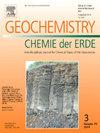用于探测与矿化有关的地球化学异常现象的极限学习机 SMOTified-GAN 增强型袋式集合模型
IF 2.6
3区 地球科学
Q2 GEOCHEMISTRY & GEOPHYSICS
引用次数: 0
摘要
本文章由计算机程序翻译,如有差异,请以英文原文为准。
A SMOTified-GAN-augmented bagging ensemble model of extreme learning machines for detecting geochemical anomalies associated with mineralization
The use of supervised machine learning and deep learning techniques to automatically detect geochemical anomalies associated with mineralization has become a current research hotspot. However, due to the scarcity of known mineral deposits in the study area, the establishment of supervised machine learning and deep learning models faces the challenge of highly imbalanced data classification. To address this challenge, the SMOTified-GAN oversampling technique and bagging strategy were combined with extreme learning machines (ELMs) to construct a robust high-performance ensemble classification model for detecting geochemical anomalies associated with mineralization. In this ensemble model, SMOTified-GAN is used to balance the ratio of positive (mineralized) to negative (background) samples in geochemical exploration data set, while keeping the sample distribution pattern of positive samples unchanged. The bagging strategy is used to construct a robust ensemble model from the simple ELM classifiers to improve the robustness of the supervised anomaly detection model. Taking the Helong area (Jilin Province, China) as the case study area, three bagging ensemble models of the simple ELM classifiers with SMOTified-GAN, GAN and SMOTE augmentations were established on the 1: 50,000 stream sediment survey data, and used to automatically detect geochemical anomalies associated with polymetallic mineralization. The receiver operating characteristic (ROC) curve of the three ensemble models are very close to the upper left corner the of the ROC space, with the SMOTified-GAN augmented bagging ensemble model dominating the other two; and the area under the ROC curves (AUCs) of the three ensemble models are very close to 1.0 (0.99998, 0.99681, and 0.96803, respectively). Therefore, in terms of ROC curves and AUCs, the SMOTified-GAN augmented bagging ensemble model has the best performance in detecting geochemical anomalies associated with polymetallic mineralization. In addition, the geochemical anomalies associated with polymetallic mineralization detected by the SMOTified-GAN augmented bagging ensemble model have the close spatial correlation with the ore-forming control factors in the study area, and are mainly distributed around known polymetallic deposits. In other words, a bagging ensemble model with high performance can be constructed from the simple ELM classifiers with SMOTified-GAN augmentation in detecting geochemical anomalies associated with mineralization.
求助全文
通过发布文献求助,成功后即可免费获取论文全文。
去求助
来源期刊

Chemie Der Erde-Geochemistry
地学-地球化学与地球物理
CiteScore
7.10
自引率
0.00%
发文量
40
审稿时长
3.0 months
期刊介绍:
GEOCHEMISTRY was founded as Chemie der Erde 1914 in Jena, and, hence, is one of the oldest journals for geochemistry-related topics.
GEOCHEMISTRY (formerly Chemie der Erde / Geochemistry) publishes original research papers, short communications, reviews of selected topics, and high-class invited review articles addressed at broad geosciences audience. Publications dealing with interdisciplinary questions are particularly welcome. Young scientists are especially encouraged to submit their work. Contributions will be published exclusively in English. The journal, through very personalized consultation and its worldwide distribution, offers entry into the world of international scientific communication, and promotes interdisciplinary discussion on chemical problems in a broad spectrum of geosciences.
The following topics are covered by the expertise of the members of the editorial board (see below):
-cosmochemistry, meteoritics-
igneous, metamorphic, and sedimentary petrology-
volcanology-
low & high temperature geochemistry-
experimental - theoretical - field related studies-
mineralogy - crystallography-
environmental geosciences-
archaeometry
 求助内容:
求助内容: 应助结果提醒方式:
应助结果提醒方式:


